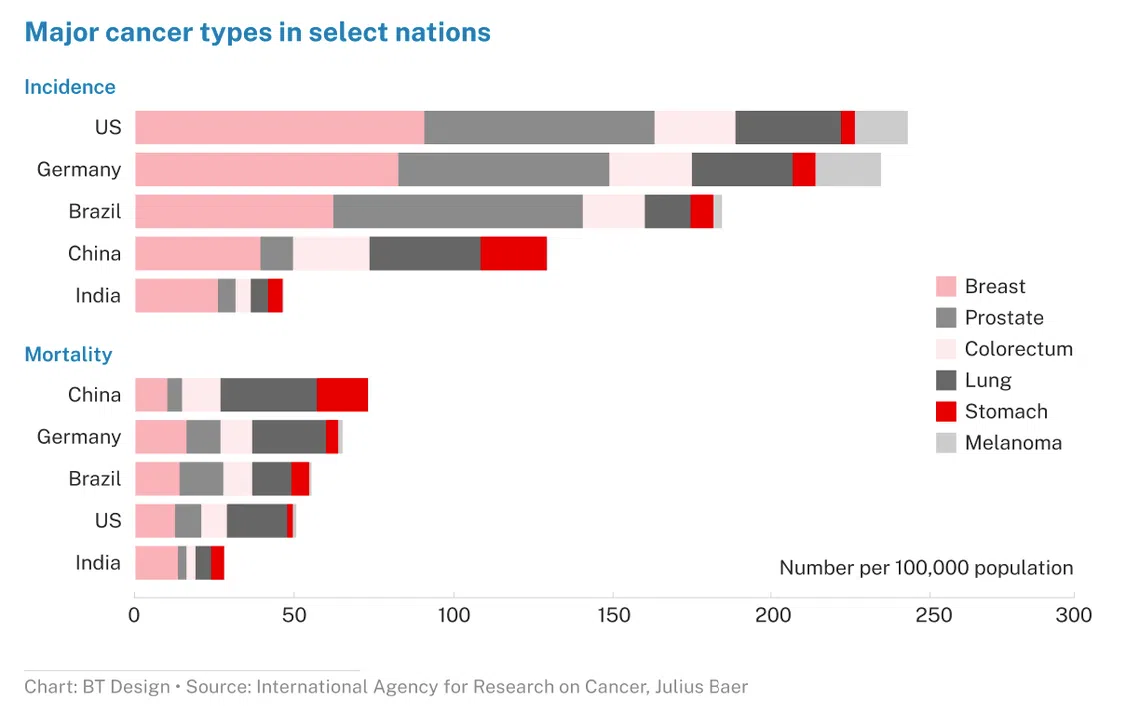Cancer’s growing burden and its investment implications
Immunotherapy is emerging as one of the most promising cancer treatments. Hence, investors should maintain a constructive view of genomics investments.
THE world’s cancer burden is intensifying, a trend that is expected to continue. It is particularly striking that some regions are more affected by the disease than others. According to the International Agency for Research in Cancer, Asia has the world’s largest share of people diagnosed with cancer. This is understandably so given that the continent is home to a huge population. Nonetheless, cancer is also on its relentless march across Europe, North America, South America, Africa, and Oceania.
The rise in the number of cancer patients globally can be attributed to several factors including excessive smoking, the immoderate consumption of alcohol and processed/red meat, a low intake of vegetables and fruits, exposure to carcinogens and radiation, infections, obesity, hormones, a lack of physical activity, genetics, and an ageing population. The World Health Organization (WHO) estimates that tobacco use accounts for 25 per cent of all cancer deaths globally and is the primary cause of lung cancer, while the insufficient intake of vegetables and fruits results in about 14 per cent of gastrointestinal cancer mortality.

While cancers relating to the breast, prostate and lung are the most common worldwide, not all countries share the same cancer burden profiles. Americans and Germans are more likely to develop skin cancer (melanoma in the cells producing melanin) than Chinese and Indians. In 2021, figures showed that men native to Brazil and many countries in Latin America and the Caribbean were more likely to contract prostate cancer than those in China or India. Put differently, there are striking geographic variations in the incidence and mortality rates of unrelated cancer types in different regions in the world.
This global diversity reflects the presence of local risk factors for specific types of cancer, the extent to which effective cancer control measures have been implemented, and the strategies each country should adopt – considering local risk factors – to fight the disease. A significant portion of the observed variation in recorded incidence and mortality rates of unrelated cancer types in different registry populations can be ascribed to the lifestyle and environmental factors present in each country.

Most commonly diagnosed cancer types in Singapore
Singapore Cancer Society’s statistics show that the most commonly diagnosed cancers for female patients between 2015 and 2019 in Singapore were located in female breast tissue (11,805 cases), colorectal and rectum (5,253), lungs (3,074), corpus uteri (2,769), as well as ovary and fallopian tubes (1,897). For male patients, the colon and rectum (6,436 cases) led, followed by the prostate (5,875), lungs (5,218), liver (2,758) and lymphoid neoplasms (2,358).
For this reason, Singapore – along with other nations – is increasingly devoted to scientific research into different types of cancer treatment to tackle the rising global burden of the disease, which claims nearly 10 million lives every year. In addition to the three main pillars of cancer treatments – chemotherapy, radiotherapy and surgery – immunotherapy is emerging as one of the most promising cancer treatments.
According to SCImago Journal & Country Rank, a measure of the scientific influence of scholarly journals, publications on cancer research from Israel and Singapore are among those most frequently cited, even though China and the US are the countries with the largest quantity of work.
Investment opportunities
In view of the growing burden of cancer worldwide and continued advances in medical technologies, the global immunotherapy industry holds great promise and could revolutionise oncology. In the US alone, oncology is estimated to be worth over US$500 billion by 2040, higher than many other therapeutic areas such as cardiovascular diseases and dermatology.
Although immunotherapy works for only a handful of cancers at present, it offers great hope in the treatment of melanomas, lymphomas, and lung, kidney, and bladder cancers, as the therapy harnesses the power of the individual’s immune system to fight against tumour cells. In other words, the increased availability of immunotherapy – with or without other forms of treatment such as chemotherapy and surgery – will offer a better chance of survival and recovery for many cancer patients. Ongoing research into extending immunotherapy to help with other forms of cancer will widen and increase its use in the future.
We therefore believe long-term investors should maintain a constructive view of the genomics investment space. Enduring structural forces range from ageing populations and the rising adoption of certain harmful lifestyle behaviour (such as tobacco use, physical inactivity, insufficient sleep, etc) to favourable political tailwinds from some governments that foster homegrown national biotechnology/pharmaceutical champions and related contract research organisations. These forces bode well for the prospects of cancer immunotherapy and other forms of genomics treatment.
The writer is thematic research analyst, Julius Baer
Decoding Asia newsletter: your guide to navigating Asia in a new global order. Sign up here to get Decoding Asia newsletter. Delivered to your inbox. Free.
Share with us your feedback on BT's products and services


